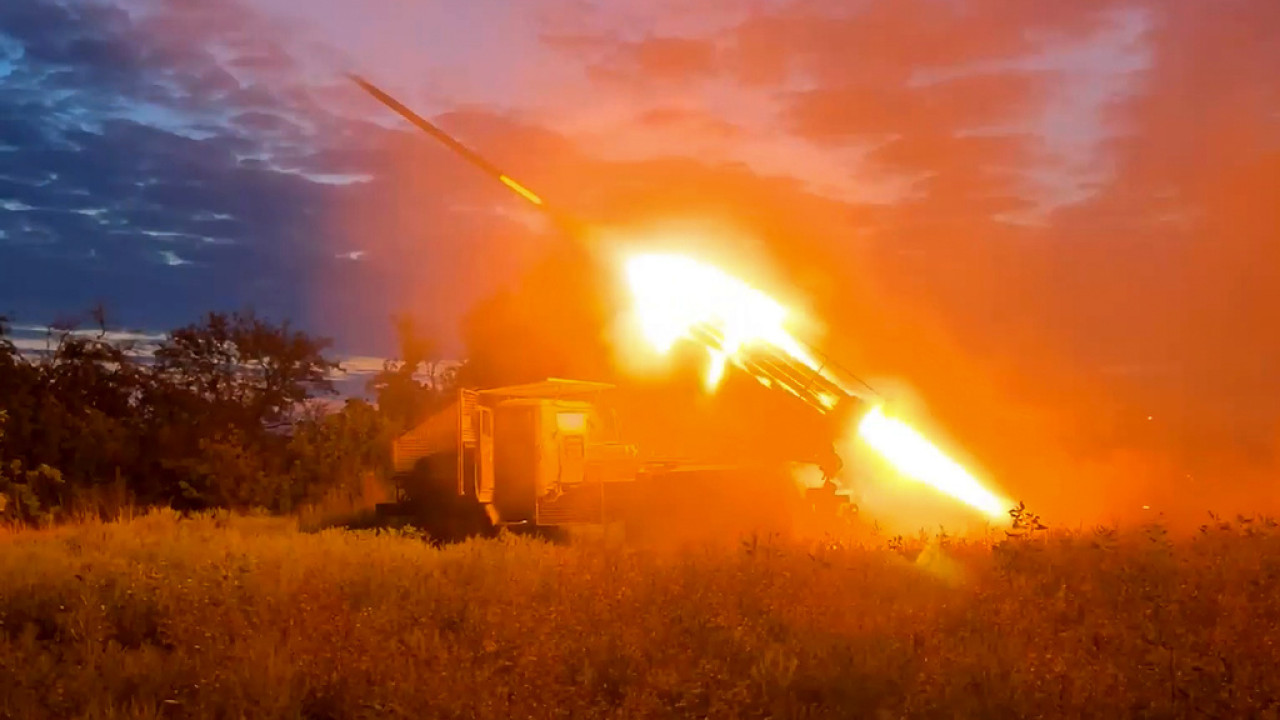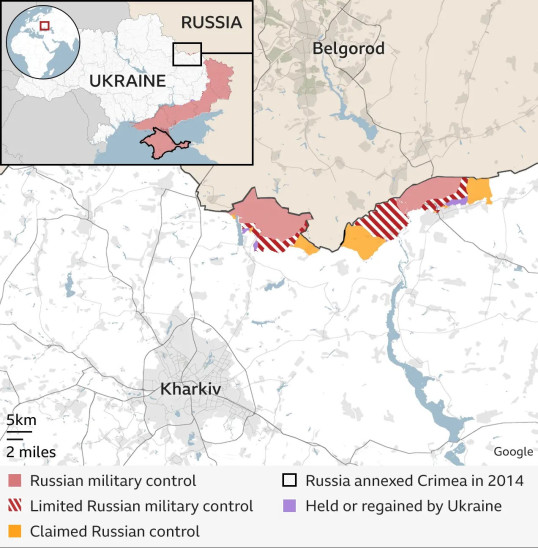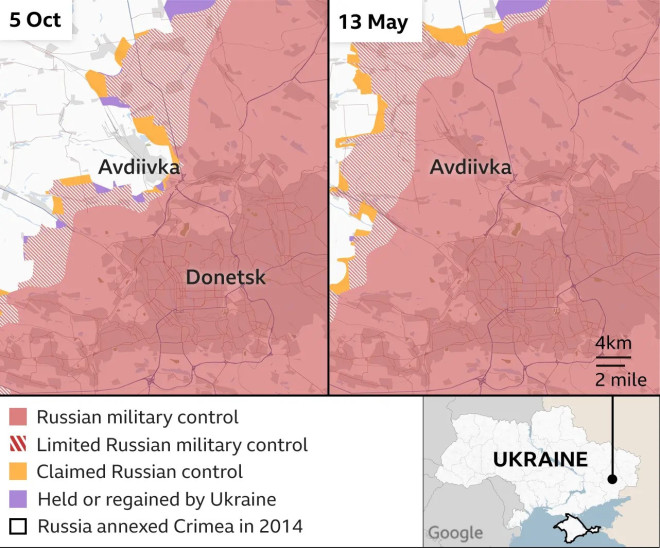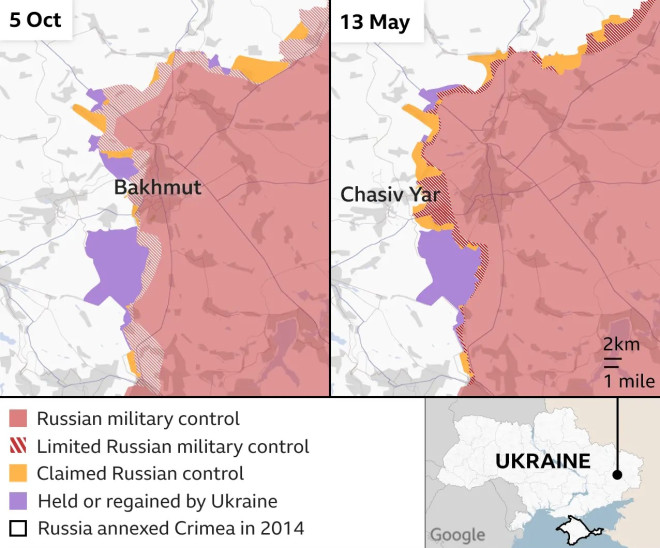
The maps show the course of the war in Ukraine and the movements of the enemy forces.
In February 2022, Russia invaded Ukrainian territory, surprising the West and Kiev. Very quickly, Russian forces occupied the entire region. Donbass In essence, they leave it. Ukraine With only one outlet to the Black Sea, via Odessa, Western support for Ukrainian forces has limited Russian advances. In recent months, Russian forces have made small territorial gains, while the Ukrainian side has launched a counter-offensive by crossing Russia’s northeastern border.
The following maps shed light on the history of the Russian-Ukrainian war, and show how the situation in Ukrainian territory evolved, as reported by BBC.
Ukrainian forces launched a counterattack and invaded Russian territory.
Ukrainian forces launched a surprise raid on the Russian border in early August, advancing 30 kilometers into Russian territory near Kursk.
About 200,000 people were evacuated from the border regions of Belovsky and Krasnaya Yaruga on the orders of the Russian government. Vladimir Putin condemned the Ukrainian attack as a “big provocation”.
A week later, Ukraine’s top general claimed that 1,000 square kilometers of Russian territory were under Ukrainian control, although analysts said the actual extent was lower.
Kursk and Belgorod declared themselves on high alert.
The current governor of Kursk, Alexei Smirnov, said Ukrainian forces had captured 28 communities, but the Ukrainian president put the number at 74.
The counterattack was seen as an attempt to force Russia to move its forces out of eastern Ukraine and thus relieve some of the pressure on Ukrainian forces there. At the same time, the Ukrainian side aims to improve its chances of concluding a peace agreement on favorable terms.
Russian raid north of Kharkiv
In early May 2024, Russian forces crossed the international border into northern Ukraine and invaded its second-largest city, Kharkiv. Several villages were captured and thousands of civilians fled.
Russia’s main offensive has long focused on the eastern Donetsk region, but this was the most significant ground offensive since the start of the war and further stretched Ukraine’s front line of defence.
The Russian attack came after a four-month period in which the United States did not supply Ukraine with weapons, due to deadlock in the US Congress.
The deadlock was broken in late April when the United States came forward with a $61 billion aid package that included supplying Ukraine with missiles, artillery and air defense systems.
Ukraine eventually “held out” despite repeated Russian warplanes bombing Kharkiv. Kharkiv thus remained out of range of Russian artillery.
Russia advances deeper into the East
The invasion of Kharkiv was independent – due to its distance – of the Russian front line on the Eastern Front, where raids would continue and deepen from October 2023.
Eastern Ukraine has been a bone of contention between the two countries since 2014, when Russian fighters seized large swathes of the eastern regions of Donetsk and Luhansk.
Russia’s greatest asset is manpower, and it has shown a willingness to sacrifice its soldiers to gain a few yards at a time.
About 1,200 Russian soldiers were killed or wounded each day in May and June, the highest rate since the start of the war, according to Western officials.
On the other hand, hoping to help relieve the strain on depleted forces on the front lines, Ukraine has lowered the minimum age for conscription from 27 to 25.
Russia has had notable success in the town of Avdiivka, where Ukrainian forces withdrew in February after months of fighting.
This represents the biggest shift in the more than 1,000-kilometre (620-mile) front line since Russian forces took control of the nearby town of Bakhmut in May 2023.
If the Ukrainian counteroffensive succeeds, Avdiivka could serve as Ukraine’s gateway to the Russian-held city of Donetsk, but that opportunity is now gone.
Almost the entire population of Avdiivka, more than 30,000 people, fled, and the town itself was almost completely destroyed.
Russian forces now control what remains of the city and continue to advance west, with their sights set on the Ukrainian-held towns of Pokrovsk and north on Chasiv Yar, about 10 kilometres west of Bakhmut.
The areas around Bakhmut remain a flashpoint and have seen some of the fiercest fighting of the war.
Although Ukraine gained some territory in the surrounding areas over the summer, Russian forces have since advanced around the city.
Two and a half years of war
The Russian invasion began with dozens of missile attacks on Ukrainian cities before dawn on February 24, 2022.
Russian ground forces moved quickly and within weeks took control of large areas of Ukraine and advanced to the outskirts of Kyiv.
Russian forces were shelling Kharkiv and occupying territory to the east and south as far as Kherson, while blockading the port of Mariupol.
How has Ukrainian land ownership changed since then?
But Russia, without expecting it, faced very strong Ukrainian resistance on all fronts, which led to heavy logistical damage. Russian forces were suffering from shortages of food, water and ammunition.
Ukrainian forces rushed to acquire weapons from the West, such as the Nallaw anti-tank system, which proved highly effective against the Russian advance.
By October 2022, the picture had changed dramatically, and after failing to capture Kyiv, Russia withdrew completely from the north. The following month, Ukrainian forces recaptured the southern city of Kherson.
Since then, the battle has been fought mainly in eastern Ukraine, where Russian forces have made slow gains on the ground after months of effort, while losing at least 50,000 soldiers and possibly more.
Read today’s news and get the latest news.
follow him Skai.gr on Google News Be the first to know all the news.

“Hipster-friendly coffee fanatic. Subtly charming bacon advocate. Friend of animals everywhere.”










More Stories
F-16 crashes in Ukraine – pilot dies due to his own error
Namibia plans to kill more than 700 wild animals to feed starving population
Endurance test for EU-Turkey relations and Ankara with Greece and Cyprus